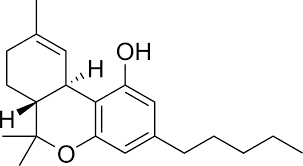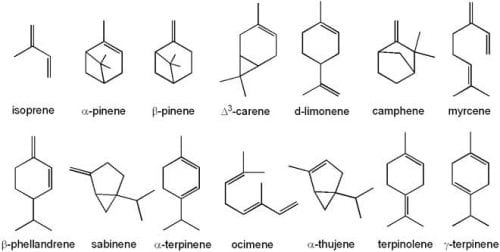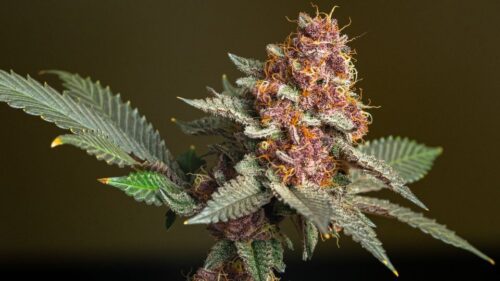There are thousands of compounds that make up cannabis; the two main types are cannabinoids and terpenes. These compounds are to thank for the effects, flavors, aromas, and visual appearance of weed. Different compounds lend different properties to the plant. And different strains contain varying types and amounts of terpenes and cannabinoids.
While these terms may have been unheard of decades ago, recent research helps us understand what cannabis contains and how it creates the different effects we experience when consuming it.
This article explains what cannabinoids and terpenes are and how they contribute to the plant.
Let’s start with cannabinoids.
Cannabinoids

THC // Image via Wiki
THC
Chances are, you’ve heard the term THC. This stands for tetrahydrocannabinol and is the psychoactive cannabinoid found in cannabis. THC-A, tetrahydrocannabinolic acid, is the precursor to THC, converting to the psychoactive compound when burned through a process called decarboxylation. THC is the most prominent and commonly found cannabinoid in weed. Typically, cannabis flower contains 10-30% THC.
CBD
Cannabidiol, better known as CBD, is the second most commonly found cannabinoid as well as a highly popular one. The widely researched compound has built a positive reputation for its many benefits without any psychoactive effects. It can be found in THC-dominant cannabis plants, typically around 1-3%, balancing out the psychoactive effects. It can also be found without THC in hemp plants or isolated products, allowing users to reap the benefits of cannabis without any psychoactive effects.
Research has shown that CBD can potentially stop or slow the growth of cancer cells, reduce nausea and vomiting, and reduce inflammation. Because of its spectrum of benefits, CBD is found seemingly everywhere nowadays, from beverages and food to soap and beauty supplies.
Other cannabinoids that are worth noting, but are less common, include CBG and CBN. They are both found in upwards of 1-2% content in cannabis.
CBG
Cannabigerol, aka CBG, is essential to the cannabis plant and is often called the “mother of all cannabinoids.” CBG-A is a precursor to THCA, CBDA, and more, with enzymes converting it to these compounds making way for decarboxylation to create THC and CBD.
CBG is shown to have potential therapeutic effects, such as pain relief, anti-inflammatory, and antibacterial properties. In fact, research has shown that CBG may be a great aid in relieving inflammatory bowel disease (IBD), Huntington’s Disease, Glaucoma, and fighting cancer cells.
CBN
CBN, aka cannabinol, is a non-intoxicating compound that is created when THC ages. Therefore, older weed may have higher amounts. Studies have shown that CBN may be antibacterial, anti-inflammatory, a powerful neuroprotectant, an appetite stimulant, and helpful for those suffering from glaucoma. CBN has a reputation for being very sedative, but research has not proven this.
There are over a hundred more cannabinoids found in cannabis, but these are four of the most common and understood.
Now let’s dive into cannabinoids’ best friends— terpenes.
Terpenes
Terpenes are chemical compounds that naturally occur in plants, including cannabis. They’re to thank for the aromas, flavors, and even colors associated with cannabis as well as the potential effects and therapeutic benefits. Terpenes work alongside cannabinoids to steer the effects of each specific strain.

Photo Credit: Sam Leishman
400 known terpenes have been found in cannabis, but only a limited amount have been studied and are known to have specific effects. Some of the most common and studied terpenes found in cannabis include limonene, linalool, myrcene, humulene, pinene, terpinolene, and caryophyllene. Potential effects include anxiety relief as well as mood-enhancing, sedative, antibacterial, antifungal, and anti-cancer properties.
Myrcene
Myrcene is the most common and abundant terpene found in cannabis. It is found in high levels in most strains and is the most common dominant terpene in flower. According to Leafly, “myrcene represents over 20% of the terpene profile in modern commercial strains.” Myrcene holds an herbal and earthy scent, lending spicy and musky notes to cannabis. It has been explored for its antioxidant, anxiolytic, antimicrobial, anti-aging, anti-inflammatory, pain-relieving, and analgesic properties.
Limonene
Limonene is the second most abundant and commonly found terpene in cannabis, and in nature overall. In addition to cannabis, it can be found in high amounts in lemons, oranges, limes, and grapefruits. It’s one of the easiest terpenes to detect in cannabis due to its notable zesty citrus flavor and aroma. It has been explored for its anti-inflammatory, anti-anxiety, antibacterial, and anticancer properties. Studies have shown that limonene has the potential to relieve stress, elevate mood, relieve heartburn and gastric reflux, and improve absorption of other terpenes and chemicals.

Photo Credit: Green CulturED
Pinene
Alpha-pinene is another common terpene found in cannabis as well as many trees and plants. As its name suggests, pinene releases a pine and foresty aroma. Pinene may promote memory retention, alertness, and improved lung function.
Caryophyllene
Caryophyllene is to thank for weed’s skunky aroma. It has been found to help protect the cells lining the digestive tract.
Linalool
Further, if you detect notes of lavender in your cannabis, linalool is the one responsible. Due to its sedative and anti-anxiety properties, users with epilepsy look towards strains high in linalool. it has the potential to act as a sedative, anti-depressant, anti-anxiety, anti-convulsant, pain reliever, and pain desensitizer.
Terpinolene
Terpinolene is another notable terpene found in weed, known as the “least-common common terpene.” It’s almost always found in a strain’s profile, but not usually in high amounts. Though, it has plenty to offer. Research suggests that this terpene has healing effects, including antibacterial, antifungal, and anti-proliferative properties, which may inhibit the growth of cancer cells. It’s also an antioxidant and is thought to have anti-insomnia and sedative properties, aiding with healthy sleep. It may even help to improve cholesterol levels and reduce the risk of heart disease.
There are countless other terpenes that lend notable elements to cannabis, but these are just a handful of the most common and researched ones. This is just a glimpse into the many benefits and elements that terpenes offer cannabis. Frequent new research continues to unveil the power of these dynamic compounds.
More Content
THE RELATIONSHIP BETWEEN BACKWOODS AND HIP-HOP
TERPENES FOR ANXIETY: 3 TERPS IN CANNABIS WITH STRESS-RELIEVING PROPERTIES
RAPPER WEED: WHICH RAPPERS HAVE CANNABIS PRODUCTS IN THE MARKET? WHO ACTUALLY HAS THE FIRE?
18 COMPANIES THAT DON’T DRUG TEST THEIR EMPLOYEES FOR WEED
7 TIPS FOR MARKETING CANNABIS AND CBD ON TIKTOK AND INSTAGRAM










